As a new 45-70 owner I am interested in opinions on why someone would opt for the larger round. The ballistics are worse for the 150 to 200 yards shots and recoil is harder. For reference I grew up in an area where most moose were taken with 30-30 or 303 british.

Ol_Joe
45-70 300gr vs 405gr
Ol_Joe
Discussion starter
60 posts
·
Joined 2020
- Add to quote Only show this user
As a new 45-70 owner I am interested in opinions on why someone would opt for the larger round. The ballistics are worse for the 150 to 200 yards shots and recoil is harder. For reference I grew up in an area where most moose were taken with 30-30 or 303 british.
7,044 posts
·
Joined 2011
I don't have an answer but since I just loaded some 300 grain Hornaday rounds I will be watching this thread.
Padraig
Padraig
17,973 posts
·
Joined 2012
I plink with the 300 grain round and hunt with the 405 grain... My shots here are under 100 yards and I reload, so I load for accuracy and as luck would have it the most accurate for the 405 grain is at the lower end of the load... Makes the recoil very manageable...
Ol_Joe
Discussion starter
60 posts
·
Joined 2020
Looks like I should try some heavier bullets. I dont take many deer, I like moose much more but like you I tend to have more short range shots.I plink with the 300 grain round and hunt with the 405 grain... My shots here are under 100 yards and I reload, so I load for accuracy and as luck would have it the most accurate for the 405 grain is at the lower end of the load
1,491 posts
·
Joined 2013
But wait, there's more.........I use 250 grain all the time.......I'm hunting accurately to 200 yards with sufficient energy and the GMX holds together without fracture with good penetration.......easy on my shoulder too.
1,352 posts
·
Joined 2019
Well for instance, you are moose hunting in thick cover and instead of a moose, you end up with a charging Grizzly!!! I’d be shooting the 405 round and not worrying about the recoil...
255 posts
·
Joined 2018
As I think about this I realize there are going to be those reading this response that may throw up in their mouth a little so for those I apologize in advance.
The 45-70 can no doubt kill any animal in North America and has taken many of the big 5 in Africa. It can be used for hogs, deer, elk, moose, black bear, and brown bear and the velocity and performance of the round is not intended to mirror the ballistic performance of the lighter smaller bullets like the 30-30 or .270 or .308 etc. There is nothing wrong with those rounds and they all have a place in hunting but when you chose to shoot the 45-70 you are choosing to shoot history. This was a black powder round when originally developed and the 405 grain hard cast lead bullet was the choice of the Army. Few people who choose the 45-70 do so because of the stellar ballistics or the flat trajectories. The heavy weight bullets plow through flesh leaving a channel designed to break bone and drain life. It does not require the mushroom or fragmentation of smaller faster bullets to do the job. To shoot the 45-70 well hunters became adept at gauging distances and allowing the arch of the bullet to fall to the target for maximum impact. Time are changing and now we know within a yard or two what the distance is through our rangefinder. Today we load hot light 250 and 300 grain rounds that have minimal drop to 200 yards and the scope cranked up to 9X allows us to see the flies buzzing around our game. The 45-70 is remarkable because you can custom load it to create different rounds for different game at different distances and I will never say there is a right or a wrong, but there is a purity of shooting big and slow that connects us with those who came before. It connects us with those who first opened the west and saw the great migrating herds and rivers teaming with fish. So when I load 405 hard cast I am paying homage to all of those who came before and saying thank you.
The 45-70 can no doubt kill any animal in North America and has taken many of the big 5 in Africa. It can be used for hogs, deer, elk, moose, black bear, and brown bear and the velocity and performance of the round is not intended to mirror the ballistic performance of the lighter smaller bullets like the 30-30 or .270 or .308 etc. There is nothing wrong with those rounds and they all have a place in hunting but when you chose to shoot the 45-70 you are choosing to shoot history. This was a black powder round when originally developed and the 405 grain hard cast lead bullet was the choice of the Army. Few people who choose the 45-70 do so because of the stellar ballistics or the flat trajectories. The heavy weight bullets plow through flesh leaving a channel designed to break bone and drain life. It does not require the mushroom or fragmentation of smaller faster bullets to do the job. To shoot the 45-70 well hunters became adept at gauging distances and allowing the arch of the bullet to fall to the target for maximum impact. Time are changing and now we know within a yard or two what the distance is through our rangefinder. Today we load hot light 250 and 300 grain rounds that have minimal drop to 200 yards and the scope cranked up to 9X allows us to see the flies buzzing around our game. The 45-70 is remarkable because you can custom load it to create different rounds for different game at different distances and I will never say there is a right or a wrong, but there is a purity of shooting big and slow that connects us with those who came before. It connects us with those who first opened the west and saw the great migrating herds and rivers teaming with fish. So when I load 405 hard cast I am paying homage to all of those who came before and saying thank you.
173 posts
·
Joined 2019
Different strokes for different folks. I have hunted with both. It depends on what you plan to hunt. Bullet weight should not be your only consideration. If I was hunting game larger than deer or dangerous game (i.e. grizzly) I would opt for the bullet with the greater sectional density which would be the heavier projectile. You owe it to the game to be familiar with the trajectory of the cartridge you are using and to know your own limitations and not shoot at distances beyond your individual skill level. Practice is the key here.
Sent from my iPad using Tapatalk
Sent from my iPad using Tapatalk
3,339 posts
·
Joined 2016
I agree with other, where the are Moose there are Bears. The 300 is plenty for most work in North America. You will get more blood shot meat with the much faster 300 gr. However, a flat meplat heavy bullet moving slower is also a very effective bullet.
For a very fine cast hunting bullet, take a look at GT Bullets on line. They have a very good lineup of 45-70 cast bullets, both flat points and hollow points. The alloy they use is also outstanding. The 94-3-3 alloy with GC is good to 2,000 fps and also soft enough for expansion at slower velocities. The hollow points are offerend in 320gr, 385gr, 400gr, and 435gr.
I have been very please with all designs I have ordered, from 25 cal to 45 cal.
For a very fine cast hunting bullet, take a look at GT Bullets on line. They have a very good lineup of 45-70 cast bullets, both flat points and hollow points. The alloy they use is also outstanding. The 94-3-3 alloy with GC is good to 2,000 fps and also soft enough for expansion at slower velocities. The hollow points are offerend in 320gr, 385gr, 400gr, and 435gr.
I have been very please with all designs I have ordered, from 25 cal to 45 cal.
220 posts
·
Joined 2019
I have killed a bunch of hogs with the old Remington 300 grain JHP’s.
I bought a box of 500 when I bought my “first year” Guide Gun back in 1998 and I still have plenty of them left.
I get them as close to 2000 fps as I can get and they make short work of hogs inside 100 yards.
I am not of the opinion these Remington 300 grain Bullets open as fast as some think.
A friend and I both shot this hog as it ran passed us at about 25 yards.
45/70 entrance on the right (as we face the pic) 243 on the left.
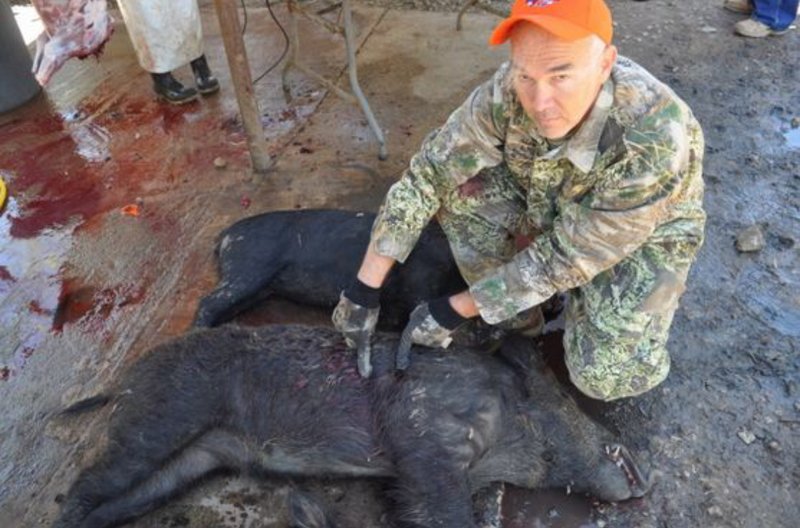
He shot first with his 243 and when it didn’t even flinch (thinking he missed) I shot it with my guide gun using the Remington 300 grain hollow points at about 1850 fps.
That animal ran another quarter mile and piled up and died in the middle of a ranch road we used to access the property.
Entrance wounds from the inside
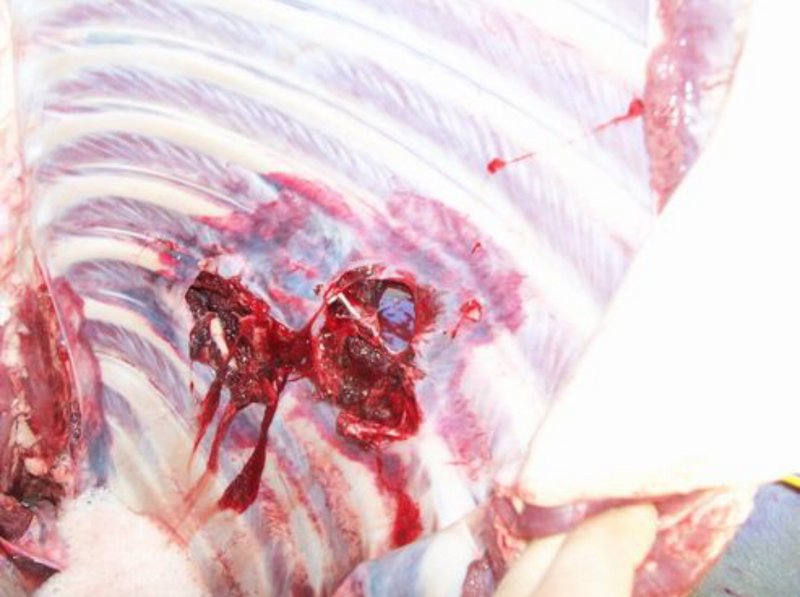
Exit wounds from the inside
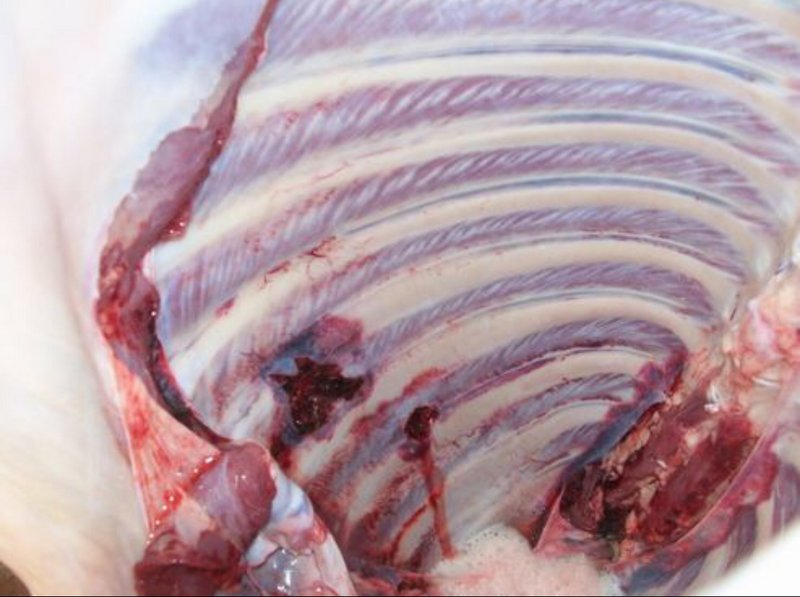
As you can see the 45 caliber hollow point sailed through without slowing down and the 243 (Barnes X Bullet) opened up properly and coasted through as well.
The 243 hit the heart and smashed it pretty good my bullet was a little farther forward and a little higher just behind the shoulder.
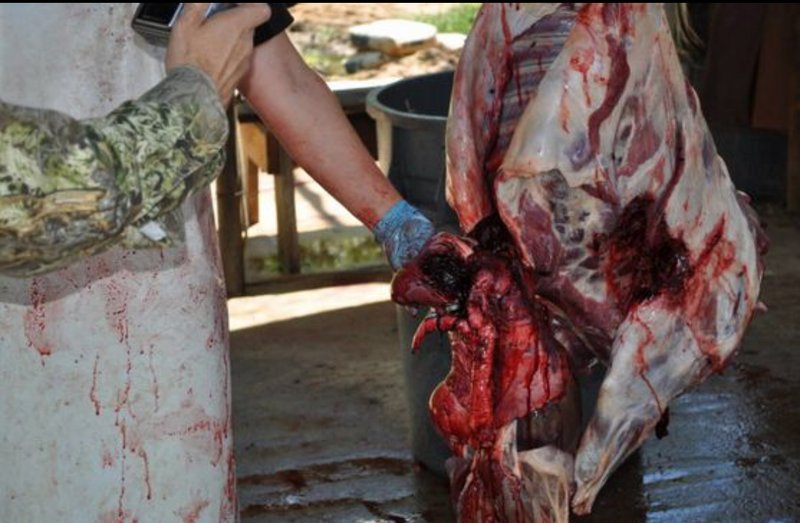
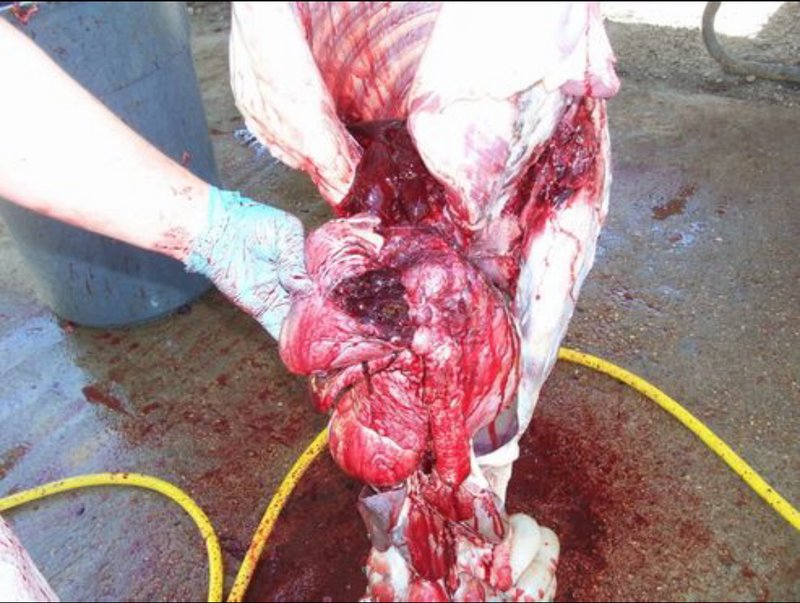
After that experience I tend to “head” shoot pigs (regardless of caliber) to keep the chasing/tracking to a minimum.
I bought a box of 500 when I bought my “first year” Guide Gun back in 1998 and I still have plenty of them left.
I get them as close to 2000 fps as I can get and they make short work of hogs inside 100 yards.
I am not of the opinion these Remington 300 grain Bullets open as fast as some think.
A friend and I both shot this hog as it ran passed us at about 25 yards.
45/70 entrance on the right (as we face the pic) 243 on the left.

He shot first with his 243 and when it didn’t even flinch (thinking he missed) I shot it with my guide gun using the Remington 300 grain hollow points at about 1850 fps.
That animal ran another quarter mile and piled up and died in the middle of a ranch road we used to access the property.
Entrance wounds from the inside

Exit wounds from the inside

As you can see the 45 caliber hollow point sailed through without slowing down and the 243 (Barnes X Bullet) opened up properly and coasted through as well.
The 243 hit the heart and smashed it pretty good my bullet was a little farther forward and a little higher just behind the shoulder.


After that experience I tend to “head” shoot pigs (regardless of caliber) to keep the chasing/tracking to a minimum.
2,520 posts
·
Joined 2014
I find a moderately loaded 405gr to be smooth shooting and has lighter recoil than common 300gr loads.
1,352 posts
·
Joined 2019
I should add, when I’m hunting in thick cover, the 405 or 420 gr I use is a +P 45/70 bear load that is leaving the barrel at close to 2000fps. Everywhere we hunt in Alaska for moose is bear country.
1,199 posts
·
Joined 2007
The 300 Hornady doesn’t need hyper velocity or recoil to work well. That bullet expands well down to at least 1350 fps. I’ve used the 400 Speer and while a bit soft for hot loads it works okay, but when I needed a tough bullet I chose the Hornady 350 RN. Killed an Alaskan brownie quite well....
.
.
6,943 posts
·
Joined 2011
Theory is, heavier bullet equals more bullet in contact with rifling. You can't make it wider, so it has to be longer. In my somewhat limited experience, 400-405gr are much more accurate (tighter groups) in my .45-70s than the 300s. In no way am I inferring you can't get accuracy out of lighter bullets.
67 posts
·
Joined 2020
I thought about the same issue with 405 vs 300 gr when I got my first 45-70. Then I found the Hornady Interlock 350 gr bullet to reload. It was a compromise between the 405 and 300. I found that that bullet behind some Varget or 3031 powder performed very well on deer. I don’t have larger game than that to hunt in my area. For plinking I like cast bullets of 405 and 450 gr but for hunting I like the Hornady 350 Interlock.
6,420 posts
·
Joined 2015
My target species is whitetailed deer, so dangerous game is not a consideration. Even so, my two loads are both heavier bullets. My jacketed bullet is the 400-grain Speer and my cast bullet is the Cast Performance 405-grain w/ gas check. I have tested a 300-grain (Sierra JHP) and a 350-grain (Hornady). They both shot accurately enough for deer hunting, but not quite as accurately as the Speer and the Cast Performance. I will be the first to say that a 300-grain bullet from a .45/70 is plenty for deer. I will also agree that my Speer and Cast Performance loads don't HAVE to be moving fast, but I'm pushing them both right at 1,800 fps according to my chrony; I use IMR 4198 for the Speer load and Varget for the Cast Performance load. I get 1.5" groups with both loads at 100 yards, so they're both accurate. Yes, they kick, but the recoil doesn't bother me. So, the big bullets work for me (probably killed about 12 deer in the past 5 years with either the Speer or the Cast Performance with the longest kill shot being 163 yards). I know I'm "over-doing it" grain-weight and velocity-wise, so to speak, but I'm having fun. And, even though bears are not in my area, should Sasquatch or a Jurassic Park escapee stroll past my elevated stand, by golly, I ready! 
427 posts
·
Joined 2020
Thanks I surprised him in his bed under a tree and shot him at around 5 yards as he popped up to escape. That was up in the Cape in North Queensland last year.
The bottom pig I shot at something like 20' when a mate and I surprised him as he and another pig were up under a log in that long grass. Mate threw a load of SG's at him and he missed which encouraged the boar to jump to light speed but a 405gn slug in the shoulder stopped him.
This fella copped a 405gn Speer between the shoulder blades as he slept in an undercut under a tree in a dried up creek bed at around 5- 10 yards.
![828326 828326]()
The bottom pig I shot at something like 20' when a mate and I surprised him as he and another pig were up under a log in that long grass. Mate threw a load of SG's at him and he missed which encouraged the boar to jump to light speed but a 405gn slug in the shoulder stopped him.
This fella copped a 405gn Speer between the shoulder blades as he slept in an undercut under a tree in a dried up creek bed at around 5- 10 yards.
582 posts
·
Joined 2008
What’s the best 45/70 factory load that just makes a huge exit hole for blood trailing. ?
1,966 posts
·
Joined 2017
I have to agree with Festus63 and buckeyshooter. In my worthless opinion, the 350gr Interlock is the single best bullet for .45-70.
But first a comment on your original post. You mentioned .30-30 and .303 Brit killed most deer and moose in your area. Many people consider .30-30 marginal or minimal for elk, moose, and big bear. Yes, it has and will kill them but it's not a great choice. The .303 is different. It's more powerful, usually loaded with heavier bullets, and flatter shooting. I would not be surprised to learn the .303 had killed more North American grizzly and brown bear than any other cartridge. It has a very long history in that role in Canada and Alaska. Heck, even the RCMP used .303 rifles for many decades.
So, why a .45-70 at all when you think a .30-30 or .303 will do? Why not just a 30-06 or a .270? Why not a 7mm Mag or an 8x57 Mauser? How about a 360 Buckhammer, 358 Win, .284 Win, 35 Rem, .308, or even a .444 Marlin? After all, any one of those could do. Paradoxically, the answer is both simple and complex.
First, nearly all of us are able to procure and use more than one rifle. Second, we tend in our thinking to specialize. That is, we tend to want one rifle for woods carry and big game, another rifle for long distance medium game hunting in open terrain, and still another rifle for close in, potentially dangerous game. So, it goes. While we could make due with one "all-around" rifle, we'd rather have a battery of rifles to choose from. Third, variety is the spice of life. We are shooting enthusiasts. We enjoy a cornicopia of cartridges and we marvel at the diverse and mechanically marvelous inventions that shoot them. The Marlin 1895 in .45-70 fits this last characterization perfectly.
To the point, if I could only have one rifle for everything and the choice was between a .30-30, a .303, and a .45-70 then I'd pick the .303 without hesitation. But if I was choosing one rifle from those calibers specifically for North American medium and large game within 150 yards I'd choose the .45-70. What the .45-70 lacks in speed it more than makes up for in momentum. It gives deep, deep penetration and cuts a wide path. The 300gr loads not as much, but they do shoot flatter. The 405gr loads, oh yeah, deep, deep penetration. But they have a rainbow shaped trajectory that one mustn't ignore for longer shots. The 350gr round nose fits right in the middle. It's not a compromise. It's the best of both worlds.
But first a comment on your original post. You mentioned .30-30 and .303 Brit killed most deer and moose in your area. Many people consider .30-30 marginal or minimal for elk, moose, and big bear. Yes, it has and will kill them but it's not a great choice. The .303 is different. It's more powerful, usually loaded with heavier bullets, and flatter shooting. I would not be surprised to learn the .303 had killed more North American grizzly and brown bear than any other cartridge. It has a very long history in that role in Canada and Alaska. Heck, even the RCMP used .303 rifles for many decades.
So, why a .45-70 at all when you think a .30-30 or .303 will do? Why not just a 30-06 or a .270? Why not a 7mm Mag or an 8x57 Mauser? How about a 360 Buckhammer, 358 Win, .284 Win, 35 Rem, .308, or even a .444 Marlin? After all, any one of those could do. Paradoxically, the answer is both simple and complex.
First, nearly all of us are able to procure and use more than one rifle. Second, we tend in our thinking to specialize. That is, we tend to want one rifle for woods carry and big game, another rifle for long distance medium game hunting in open terrain, and still another rifle for close in, potentially dangerous game. So, it goes. While we could make due with one "all-around" rifle, we'd rather have a battery of rifles to choose from. Third, variety is the spice of life. We are shooting enthusiasts. We enjoy a cornicopia of cartridges and we marvel at the diverse and mechanically marvelous inventions that shoot them. The Marlin 1895 in .45-70 fits this last characterization perfectly.
To the point, if I could only have one rifle for everything and the choice was between a .30-30, a .303, and a .45-70 then I'd pick the .303 without hesitation. But if I was choosing one rifle from those calibers specifically for North American medium and large game within 150 yards I'd choose the .45-70. What the .45-70 lacks in speed it more than makes up for in momentum. It gives deep, deep penetration and cuts a wide path. The 300gr loads not as much, but they do shoot flatter. The 405gr loads, oh yeah, deep, deep penetration. But they have a rainbow shaped trajectory that one mustn't ignore for longer shots. The 350gr round nose fits right in the middle. It's not a compromise. It's the best of both worlds.
582 posts
·
Joined 2008
I need a large exit wound for my deer and larger game. So your saying 300g?
2,471 posts
·
Joined 2006
Tailor the bullet to the game. For deer I found the reloads of top end, and Speer 300 JHP, are devastating. But I lung shoot. Shoulder shots will destroy a lot of meat.
I once picked up a box of the WInchester 300 JHP and found it to be good shooting from a Browning 1886 I had. Velocity registered an ironic 1886 fps. out of the 26" barrel.
I once picked up a box of the WInchester 300 JHP and found it to be good shooting from a Browning 1886 I had. Velocity registered an ironic 1886 fps. out of the 26" barrel.
318 posts
·
Joined 2018
I have used the Barnes Original 300 grain on quite a few elk and a moose, a few deer - it usually leaves an exit hole. Due to recoil, I quickly left the 350 and 400 grain bullets behind, finding the 300 grain bullet works very well. Trajectory is noticeably flatter with the 300 grain bullet, noticeable beyond 80 yards or so. I have had no reason to fool with heavier bullets, most of my elk have been shot between 60 and 130 yards but there is a 180 yard cow and a 340 yard large bodied 5x7 bull. Both shot in a large high country pasture well known to me(9100 feet - 1 mile by 3 miles). There was a Nosler 300gr Partition and Barnes also has a 300gr TSX for the 45-70. The older Barnes X and the Nosler did not shoot accurately in my Marlin 1895 but the Barnes Original 300gr goes under 1.5" at a hundred, the Sierra 300gr 45-70 bullet is more accurate and cheaper but expands to much for heavier game. If I decide to shoot a Bison I will probably try the new Barnes TSX or maybe a heavier bullet.
582 posts
·
Joined 2008
Just shot a buck with a Remington 405g Cor-lokt factory ammo load. Tore through the ribs on one side and out through the shoulder other side. Very very little blood and small exit. Ran about 50 yards and was still alive. One more went through and through. I’d like a bigger exit hole!
427 posts
·
Joined 2020
Northern Territory boar I shot with my 45/70 around 50 yards..............the 405 gn Speer went in behind his right front shoulder and exited just in front of his left front leg and on into the mud behind him.............estimated weight is around the 100kg mark
-
?
-
?
-
?
-
?
-
?
-
?
-
?
-
?
-
?
-
?
-
?
-
?
-
?
-
?
-
?
-
?
-
?
-
?
-
?
-
?
- posts
- 4.2M
- members
- 107K
- Since
- 2004
MarlinOwners.com is a community of Marlin Firearm Owners - Dedicated to discussing Marlin Firearms, Marlin Rifles and more. Pictures, help, discussions and more.
Explore Our Forums
Top Contributors this Month
View All
TnHunter356
283 Replies
no primers
224 Replies
cajun56
206 Replies



